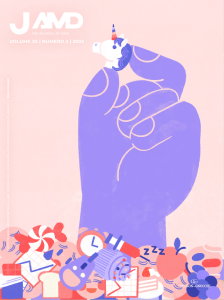Original articles
Front of pack labelling and health
JAMD 2023;26(2):74-79
In Europe, more than half of the resident adult population is overweight or obese. Obesity is also one of the major causes of the development of diseases such as diabetes, cardiovascular disease, and some types of cancer. Among the strategies promoted to counteract obesity and re[1]lated diseases, some ideas are growing, aimed at developing a further form of labeling on the front of the pack (hence the term Front of Pack or FoP), which directs the consumer immediately and effectively towards conscious and healthy nutritional choices. Numerous front labeling systems have been proposed in recent years. As far as the European debate is concerned, the main front-of-pack labeling proposals are the Nutri-Score and the NutrInform Battery, tools that have sparked debate both at an academic and political level. Both systems have strengths and weaknesses, but they were born with the same purpose of helping the consumer to make balanced and informed choices. Choosing a FoP system capable of helping consumers to orient themselves in the world of the food market is certainly complex. It would be desirable to have a tool capable of providing synthetically complete information, easy to read and quick to interpret, considering the country of reference, and socio-cultural characteristics.
KEY WORDS nutrition; health; labelling; front of pack; Europe.
Critical review of 2021 AMD Annals data on the elderly population with type 2 diabetes
JAMD 2023;26(2):80-93
The AMD Annals 2021 “Diabetes in the Elderly” aim to show how assistance to elderly patients with type 2 diabetes mellitus has evolved, evaluating data related to AMD indicators.
DESIGN AND METHODS 531,732 patients with T2DM were evaluated, data divided by age groups (<65 years, between 65 and 74, >75 years) followed in 2019, regarding clinical characteristics and activity volume. The selection of indicators is based on a large number of the current AMD Indicator List (June 2019). The evaluation of overall care quality was carried out through the Q score.
RESULTS The 2021 AMD Annals show that among the 531,732 registered diabetes patients in 2019, 33.4% were over 75 years old. 3.8% of new diagnoses were over 75 years old and 5.2% were between 65 and 74 years old. HbA1c, lipid profile, blood pressure profile, microalbuminuria monitoring, foot inspection, and fundus control were considered. Overall, the areas related to glycemic-metabolic control do not show significant differences in the different age groups. Attention to HbA1c monitoring is very high, at 96.4%. Microalbuminuria is less evaluated, where registration is insufficient in all age groups. Creatinine determination is highly regarded, mainly registered in those over 75. Just under 50% of the DM2 diabetic population, especially the elderly, is not monitored (or only not recorded) in the comprehensive cardiovascular risk profile, including lipid profile, HbA1c, microalbuminuria, creatinine, and blood pressure. Foot evaluation always represents a serious issue in diabetes care: the data is only present in 19.1% of patients. Finally, the analysis of retinopathy highlights another critical aspect of care, with 65% of patients over 65 not undergoing (or the data not being recorded) specific screening; the problem is even more evident among those over 75, where the lack of information affected 69% of patients. The overall care quality indicators expressed by the Q score also show very good values in the elderly population, even in the population aged between 65 and 75 years, where 64.1% of patients have a Q score >25, higher than patients under 65 years old (60.7%).
CONCLUSIONS The analysis of data collected in the context of the AMD Annals is always an important moment of reflection for diabetes care. The growing trend of the elderly population accessing diabetes services is confirmed, and the prevalence of patients over 75 is significantly higher than ten years ago. The care of elderly diabetic patients, especially the very elderly with a long history of disease, complications, and comorbidities, requires constant review of therapeutic and diagnostic approaches by the clinical diabetologist.
KEY WORDS T2DM (type 2 diabetes); HbA1c (glycated hemoglobin); SBP (systolic blood pressure); DBP (diastolic blood pressure); BP (blood pressure).
Post Transplantation Diabetes Mellitus
JAMD 2023;26(2):96-106
With increasing success in overcoming the immunological and infectious challenges associated with solid organ transplantation, the susceptibility to post-transplant diabetes (PTDM) has gained increasing importance. There is general agreement that both insulin resistance and β-cell dysfunction contribute to the development and manifestation of post-transplant diabetes, but controversy remains as to which is most important. The risk factors for PTDM are well established and include both general and transplant-specific factors. The clinical significance of PTDM is as a significant risk factor for cardiovascular and chronic kidney disease after solid organ transplantation. Considering all these important factors and the potential cardio- and renoprotective effects of the new antidiabetic agents, it is necessary to evaluate these new therapeutic strategies in PTDM.
KEY WORDS post transplantation diabetes mellitus; immunosuppression; organ transplant
LADA, a type 1.5 diabetes?
JAMD 2023;26(2):107-118
Patients with autoimmune diabetes mellitus show a certain variability from an epidemiological, pathogenetic and clinical point of view. Within this phenotypic variety, LADA has been described as a type of autoimmune diabetes with a latent course, characterized by onset in adulthood and slower progression towards insulin therapy if compared to the classic form of type 1 diabetes. The proposed diagnostic criteria for LADA are age of onset after 30 years, antibody positivity, insulin independence for at least six months after diagnosis. However, in clinical practice it is common experience to observe that age of onset largely overlaps with other forms of diabetes, that in the history of diabetes antibodies positivity can be changeable and that shared criteria defining the time of insulin therapy starting after diagnosis of diabetes are lacking. On the other hand, correctly identifying patients with autoimmune diabetes is essential both from a clinical point of view, to offer them the best therapeutic approach, and in the pre-clinical phase because of the availability in the near future of immunotherapies that can delay the onset of the insulin therapy in the natural history of diabetes. Therefore, this review focuses on the clinical characteristics of LADA and on possible strategies to identify patients with this type of diabetes, in order to offer them therapeutic options that, in addition to obtaining adequate glycemic control, aim to preserve beta cell function during the natural history of autoimmune diabetes.
KEY WORDS insulin; autoimmunity; adult; antibodies; latent
Secondary diabetes mellitus: focusing on type 3c diabetes and post-immunotherapy new onset diabetes
JAMD 2023;26(2):119-127
Although the most frequent subtype of diabetes mellitus (DM) globally is type 2 DM (DMT2), pathophysiologically associated with insuline resistance, a small but significant portion of DM cases is caused by other clinical conditions, such as drugs, hormonal derangements, etc.: this clinical entity goes by the name of secondary diabetes. It is a highly heterogeneous condition, given the fact that it may be produced by a number of different conditions, like pancreas-related conditions, cystic fibrosis and other systemic diseases, endocrinopathies, drug-related metabolic derangements, etc. In this subtype of DM it is possible to find both well-known-diseases (like steroid-induced DM) and more recently-characterized conditions (such as post-immunotherapy DM). Given its etiological heterogeneity, secondary diabetes presents often with various clinical characteristics and needs peculiar management strategies. It is therefore essential for clinicians to be able to comprehend the etiological, clinical and therapeutical features of these different subtypes of DM, in order to accurately recognise, manage and treat subjects with these conditions. This review, therefore, focuses on the clinical characteristics of two particular subtypes of secondary diabetes, that is type 3c diabetes and post-immunotherapy diabetes.
KEY WORDS pancreatitis; pancreatic carcinoma; exocrine insufficiency; oncology; immune checkpoint inhibitors.
Precision medicine: monogenic diabetes
JAMD 2023;26(2):128-139
Monogenic diabetes refers to diabetes mellitus caused by a mutation in a single gene and/or chromosomal locus resulting in a deficit in the number or function of pancreatic beta cells. Despite all the signs of progress made in the diagnostic-therapeutic field, it is sometimes still difficult to make an early diagnosis of monogenic diabetes. Because of this reason, the idea of precision medicine in diabetes has been developed, defining it as an approach to optimize the diagnosis, prediction, prevention, or treatment of diabetes by integrating multidimensional data, thus improving the quality of life of patients with diabetes. Probabilistic algorithms and calculators that consider family history, clinical and biochemical characteristics, have been developed to identify candidates for Next-Generation Sequencing (NGS) analysis. Precision diagnosis and treatment have an important impact on managing the various forms of monogenic diabetes: for example, some cases of neonatal diabetes (NDM) and Maturity Onset Diabetes of the Young (MODY) are sensitive to sulfonylureas and precision treatment results in cessation of insulin treatment. Genetic diagnosis also makes it possible to predict disease-related outcomes and complications and, therefore, to carry out a targeted follow-up: patients with Wolfram’s syndrome must be monitored for associated disease from the kidney, liver and neurological point of view. In conclusion, the application of precision medicine in diagnosis and in treatment of monogenic diabetes is a standard of care, based on the improvement in the quality of life that it can guarantee to these patients. The same treatment approach is not currently applicable to the other forms of diabetes. Future steps will be achieved if, thanks to this diagnostic paradigm, we will be able to prevent the onset of monogenic diabetes.
KEY WORDS precision medicine; diabetes mellitus; neonatal diabetes; MODY; children.
Surveys
What do we know about drug functioning according to gender? The results of the “Drugs and Gender” survey
JAMD 2023;26(2):140-156
Drugs have different efficacy and toxicity profiles, according to gender. The “sexome” reflects the sum of sex-biased effects on gene networks and cell systems and leads to the main pharma-cokinetic and pharmacodynamic differences between sexes, with more side effects and lower dose requirement in women. Therefore, since 2014, it has been recommended to design clinical trials equally involving both sexes/genders, since so far male participation has always been prevalent. The aim of this survey was to explore the level of Italian diabetologists awareness and knowledge about sex-related metabolism and effects of drugs which are frequently used for treatment and prevention of diabetes and its complications. Consistent with the historical period, indepth study on Sars- Cov 2 vaccines was included. The survey, which included fifteen multiple choice questions, was sent to AMD members (Associazione dei Medici Diabetologi) from the 1st of May to the end of June 2022. A hundred-twenty-eight diabetologists, working in the outpatient clinics and hospitals of the National Health System located throughout the national territory, replied to the survey. The answers to the survey show that the greatest uncertainty was about the use of ‘cardiovascular’ drugs, such as spironolactone and anti-hypertensive drugs, while the best knowledge was for antidiabetic agents, in particular metformin. Little is known about the effects of the Sars-Cov2 vaccines in the two genders. Despite the limitations of the study due to the small sample size (128 participants, about 10% of AMD subscribers), the “gender and drugs” survey highlighted the need to train diabetologists on different drug response according to sex, as well as to design studies focusing on sex-related disparities in dose, efficacy and side effects of drugs, promoting gender equity in health care.
KEY WORDS gender; drugs; knowledge; equity.
Documento di consenso
Recommendations on the management of glycemic homeostasis disorders secondary to haematological disease, oncological disease and organ transplantation in the pediatric age
JAMD 2023;26(2):157-172





